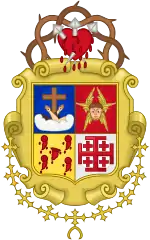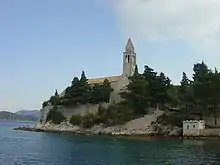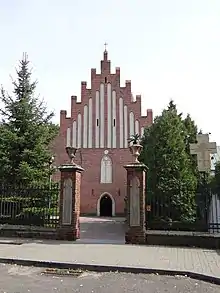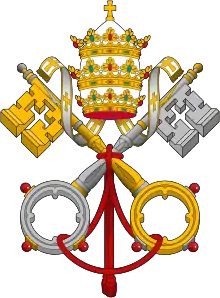Order of Friars Minor
The Order of Friars Minor (also called the Franciscans, the Franciscan Order, or the Seraphic Order;[1] postnominal abbreviation OFM) is a mendicant Catholic religious order, founded in 1209 by Francis of Assisi. The order adheres to the teachings and spiritual disciplines of the founder and of his main associates and followers, such as Clare of Assisi, Anthony of Padua, and Elizabeth of Hungary, among many others. The Order of Friars Minor is the largest of the contemporary First Orders within the Franciscan movement.
Ordo Fratrum Minorum | |
 Coat of arms of the Order of Friars Minor | |
| Abbreviation | OFM, Franciscan |
|---|---|
| Motto | Pax et bonum ("Peace and the good") |
| Formation | February 24, 1209 |
| Founder | Saint Francis of Assisi |
| Type | Mendicant Catholic religious order |
| Legal status | Religious institute |
| Headquarters | Porziuncola |
| Location | |
| Michael A. Perry | |
Main organ | General Curia |
Parent organization | Catholic Church |
| Subsidiaries | Secular Franciscan Order (1221) Third Order of Saint Francis (1447) |
| Secessions | Order of Friars Minor Conventual (1517) Order of Friars Minor Capuchin (1520) |
| Affiliations | Order of Saint Clare (1212) |
| Website | ofm |

Francis began preaching around 1207 and traveled to Rome to seek approval of his order from Pope Innocent III in 1209. The original Rule of Saint Francis approved by the pope disallowed ownership of property, requiring members of the order to beg for food while preaching. The austerity was meant to emulate the life and ministry of Jesus Christ. Franciscans traveled and preached in the streets, while boarding in church properties. The extreme poverty required of members was relaxed in final revision of the Rule in 1223. The degree of observance required of members remained a major source of conflict within the order, resulting in numerous secessions.[2][3]
The Order of Friars Minor, previously known as the Observant branch (postnominal abbreviation OFM Obs.), is one of the three Franciscan First Orders within the Catholic Church, the others being the Capuchins (postnominal abbreviation OFM Cap.) and Conventuals (postnominal abbreviation OFM Conv). The Order of Friars Minor, in its current form, is the result of an amalgamation of several smaller Franciscan orders (e.g. Alcantarines, Recollects, Reformanti, etc.), completed in 1897 by Pope Leo XIII.[4] The Capuchin and Conventual remain distinct religious institutes within the Catholic Church, observing the Rule of Saint Francis with different emphases. Franciscans are sometimes referred to as minorites or greyfriars because of their habit. In Poland and Lithuania they are known as Bernardines, after Bernardino of Siena, although the term elsewhere refers rather to Cistercians.
Name and demographics
The "Order of Friars Minor" are commonly called simply the "Franciscans". This Order is a mendicant religious order of men that traces its origin to Francis of Assisi.[5] Their official Latin name is the Ordo Fratrum Minorum.[6]
The modern organization of the Friars Minor comprises three separate families or groups, each considered a religious order in its own right under its own minister General and particular type of governance. They all live according to a body of regulations known as the Rule of St Francis.[5] These are
- The Order of Friars Minor, known as the "Observants", most commonly simply called Franciscan friars,[5] official name: "Friars Minor" (OFM).[7]
- The Order of Friars Minor Capuchin or simply Capuchins,[5] official name: "Friars Minor Capuchin" (OFM Cap).[7]
- The Conventual Franciscans or Minorites,[5] official name: "Friars Minor Conventual" (OFM Conv).[7]
The 2013 Annuario Pontificio gave the following figures for the membership of the principal male Franciscan orders:[8]
- Order of Friars Minor (OFM): 2,212 communities; 14,123 members; 9,735 priests
- Franciscan Order of Friars Minor Capuchin (OFMCap): 1,633 communities; 10,786 members; 7,057 priests
- Franciscan Order of Friars Minor Conventual (OFMConv): 667 communities; 4,289 members; 2,921 priests
- Third Order Regular of Saint Francis (TOR): 176 communities; 870 members; 576 priests
History
Beginnings
A sermon on Mt 10:9 which Francis heard in 1209 made such an impression on him that he decided to fully devote himself to a life of apostolic poverty. Clad in a rough garment, barefoot, and, after the Evangelical precept, without staff or scrip, he began to preach repentance.[9]
The mendicant orders had long been exempt from the jurisdiction of the bishop, and enjoyed (as distinguished from the secular clergy) unrestricted freedom to preach and hear confessions in the churches connected with their monasteries. This had led to endless friction and open quarrels between the two divisions of the clergy. This question was definitively settled by the Council of Trent.[4]

Separate congregations
Amid numerous dissensions in the 14th century, a number of separate congregations sprang up, almost of sects, to say nothing of the heretical parties of the Beghards and Fraticelli, some of which developed within the order on both hermit and cenobitic principles.
- The Clareni or Clarenini, an association of hermits established on the river Clareno in the march of Ancona by Angelo da Clareno after the suppression of the Franciscan Celestines by Boniface VIII. Like several other smaller congregations, it was obliged in 1568 under Pope Pius V to unite with the general body of Observantists.
- The quasi-Observantist brothers living under the rule of the Conventual ministers (Martinianists or "Observantes sub ministris"), such as the male Colletans, later led by Boniface de Ceva in his reform attempts principally in France and Germany;
- The reformed congregation founded in 1426 by the Spaniard Philip de Berbegal and distinguished by the special importance they attached to the little hood (cappuciola);
- The Neutri, a group of reformers originating about 1463 in Italy, who tried to take a middle ground between the Conventuals and Observantists, but refused to obey the heads of either, until they were compelled by the pope to affiliate with the regular Observantists, or with those of the Common Life;
- The Caperolani, a congregation founded about 1470 in North Italy by Peter Caperolo, but dissolved on the death of its founder in 1481;
A difference of opinion developed in the community concerning the interpretation of the rule regarding property. The Observants held to a strict interpretation that the friars may not hold any property either individually nor communally. The literal and unconditional observance of this was rendered impracticable by the great expansion of the order, its pursuit of learning, and the accumulated property of the large cloisters in the towns. Regulations were drafted by which all alms donated were held by custodians appointed by the Holy See, who would make distributions upon request. It was John XXII who had introduced Conventualism in the sense of community of goods, income, and property as in other religious orders, in contradiction to Observantism or the strict observance of the rule. Pope Martin V, in the Brief Ad statum of 23 August 1430, allowed the Conventuals to hold property like all other orders.[4]
Projects for a union between the two main branches of the order were put forth not only by the Council of Constance but by several popes, without any positive result. By direction of Pope Martin V, John of Capistrano drew up statutes which were to serve as a basis for reunion, and they were actually accepted by a general chapter at Assisi in 1430; but the majority of the Conventual houses refused to agree to them, and they remained without effect. Equally unsuccessful were the attempts of the Franciscan Pope Sixtus IV, who bestowed a vast number of privileges on both original mendicant orders, but by this very fact lost the favor of the Observants and failed in his plans for reunion. Julius II succeeded in doing away with some of the smaller branches, but left the division of the two great parties untouched. This division was finally legalized by Leo X, after a general chapter held in Rome in 1517, in connection with the reform movement of the Fifth Lateran Council, had once more declared the impossibility of reunion. Leo X summoned on 11 July 1516 a general chapter to meet at Rome on the feast of Pentecost 31 May 1517. This chapter suppressed all the reformed congregations and annexed them to the Observants; it then declared the Observants an independent order, and separated them completely from the Conventuals.[4] The less strict principles of the Conventuals, permitting the possession of real estate and the enjoyment of fixed revenues, were recognized as tolerable, while the Observants, in contrast to this usus moderatus, were held strictly to their own usus arctus or pauper.
Unification
All of the groups that followed the Franciscan Rule literally were united to the Observants, and the right to elect the Minister General of the Order, together with the seal of the order, was given to the group united under the Observants. This grouping, since it adhered more closely to the rule of the founder, was allowed to claim a certain superiority over the Conventuals. The Observant general (elected now for six years, not for life) inherited the title of "Minister-General of the Whole Order of St. Francis" and was granted the right to confirm the choice of a head for the Conventuals, who was known as "Master-General of the Friars Minor Conventual"—although this privilege never became practically operative.
In 1875, the Kulturkampf expelled the majority of the German Franciscans, most of whom settled in North America.[4]
Habit
The habit has been gradually changed in colour and certain other details. Its colour, which was at first grey or a medium brown, is now a dark brown. The dress, which consists of a loose sleeved gown, is confined by a white cord, from which is hung, since the fifteenth century, the Seraphic rosary with its seven decades. Sandals are substituted for shoes. Around the neck and over the shoulders hangs the cowl.[4]
Saints and Beati
Canonized
- Francis of Assisi, d. 3 October 1226 (4 October);[10]
- Berard of Carbio and four companions, martyred 1220 (16 January);[11]
- Peter Baptist and twenty-five companions, martyred at Nagasaki, Japan, 1597 (5 February);[12]
- John Joseph of the Cross, d. 1734 (5 March);[13]
- Benedict the Moor, d. 1589 (3 April); [14]
- Peter Regalda, d 1456 (13 May);[15]
- Paschal Baylon, d. 1592 (17 May);[16]
- Bernardino of Siena, d. 1444 (20 May);[17]
- Anthony of Padua, d. 1231 (13 June);[18]
- Nicholas Pieck, hanged by les Gueux at Gorkum (Holland) in 1572 with eighteen companions, of whom eleven were Franciscans (9 July);[19]
- Bonaventure, d. 1274 (15 July);[20]
- Francis Solanus, the Apostle of South America, d. 1610 (24 July);[21]
- Louis of Toulouse, Bishop of Toulouse, d. 1297 (19 August); [22]
- Pacificus of San Severino, d. 1721 (25 September);[23]
- Peter of Alcantara., d. 1562 (19 October);[24]
- John of Capistrano, d. 1456 (23 October);[25]
- Didacus of Alcalá (Diego), d. 1463 (12 November);[26]
- Leonard of Port Maurice, d. 1751 (26 November);[27]
- James of the Marches (Monteprandone), d. 1476 (28 November).[28]
- Szymon of Lipnica, d. 1482 (18 July);[4]
- John of Perugia and Peter of Sassoferrato, martyred at Valencia in Spain, 1231 (3 Sept.);[4]
- Humilis of Bisignano, d. 1637 (5 Dec.);[29]
- Charles of Sezze[30]
- Tommaso da Cori[30]
- Frei Galvão, First Brazilian-born saint, d. 1822 (11 May)[31]
- Padre Pio, d. 23rd September 1968.
- Junipero Serra, d. 28 August 1784[32]
Beatified
- Odoric of Pordenone, d. 1331 (3 February);[30]
- Tommaso da Cori, d. 1720 (28 Feb.);[33]
- Salvator of Horta, d. 1567 (18 March);[4]
- John of Parma, d. 1289 (20 March);[34]
- Thomas of Tolentino, martyred in Further India, 1321, (6 April);[4]
- Angelo Carletti di Chivasso, d. 1495 (12 April);[35]
- Conrad of Ascoli, d. 1290, (19 April);[36]
- Agnellus of Pisa, d. 1236, (8 May);[37]
- Francis of Fabriano, d. 1322 (14 May);[38]
- John Forest, martyred at London, 1538 (22 May);[39]
- Pacificus of Ceredano, d. 1482 (5 June);[40]
- John of Laverna, d. about 1325 (9 Aug.);[41]
- Apollinaris Franco with thirty-nine companions of the First and Third Orders, martyred in Japan, 1617-32 (12 Sept);[4]
- Bernardine of Feltre, d. 1494 (28 Sept.);[42]
- Conrad of Offida, d. 1306 (19 Dec.); [43]
- Nicolás Factor, d. 1583 (23 Dec.)
See also
References
Notes
- "Seraphic Order", New Catholic Dictionary. 4 September 2006. Retrieved 25 November 2012.
- "Franciscans, Religious Order". Encyclopaedia Britannica. 26 February 2013. Retrieved 7 January 2017.
- "Saint Francis of Assisi, Italian Saint". Encyclopaedia Britannica. 26 February 2013. Retrieved 7 January 2017.
-
 One or more of the preceding sentences incorporates text from a publication now in the public domain: Bihl, Michael (1909). "Order of Friars Minor". In Herbermann, Charles (ed.). Catholic Encyclopedia. 6. New York: Robert Appleton Company. Retrieved 21 December 2017.
One or more of the preceding sentences incorporates text from a publication now in the public domain: Bihl, Michael (1909). "Order of Friars Minor". In Herbermann, Charles (ed.). Catholic Encyclopedia. 6. New York: Robert Appleton Company. Retrieved 21 December 2017. - "The rule of the Franciscan Order from the Medieval Sourcebook". Fordham.edu. 1999-09-22. Archived from the original on 2013-05-27. Retrieved 2013-06-16.
- Paschal Robinson (1913). . In Herbermann, Charles (ed.). Catholic Encyclopedia. New York: Robert Appleton Company.
- Paschal Robinson (1913). . In Herbermann, Charles (ed.). Catholic Encyclopedia. New York: Robert Appleton Company.
- Annuario Pontificio 2013 (Libreria Editrice Vaticana 2013 ISBN 978-88-209-9070-1), p. 1422
- Paschal Robinson (1913). . In Herbermann, Charles (ed.). Catholic Encyclopedia. New York: Robert Appleton Company.
- Robinson, Paschal. "St. Francis of Assisi." The Catholic Encyclopedia Vol. 6. New York: Robert Appleton Company, 1909. 15 May 2018
- Donovan, Stephen. "St. Berard of Carbio." The Catholic Encyclopedia Vol. 2. New York: Robert Appleton Company, 1907. 15 May 2018
- Heckmann, Ferdinand. "Sts. Peter Baptist and Twenty-Five Companions." The Catholic Encyclopedia Vol. 11. New York: Robert Appleton Company, 1911. 15 May 2018
- Hess, Lawrence. "St. John Joseph of the Cross." The Catholic Encyclopedia Vol. 8. New York: Robert Appleton Company, 1910. 15 May 2018
- Berchman's Bittle, O.F.M.Cap. "St Benedict the Moor", "A Saint A Day" The Bruce Publishing Company, 1958
- Heckmann, Ferdinand. "St. Peter de Regalado." The Catholic Encyclopedia Vol. 11. New York: Robert Appleton Company, 1911. 15 May 2018
- Staniforth, Oswald. "St. Pascal Baylon." The Catholic Encyclopedia Vol. 11. New York: Robert Appleton Company, 1911. 15 May 2018
- "Butler, Rev. Alban, The Lives of the Fathers, Martyrs and Other Principal Saints, Vol. V, by the Rev. Alban Butler, D. & J. Sadlier, & Company, 1864". Archived from the original on 2013-06-18. Retrieved 2018-05-15.
- Dal-Gal, Niccolò. "St. Anthony of Padua." The Catholic Encyclopedia Vol. 1. New York: Robert Appleton Company, 1907. 15 May 2018
- Heckmann, Ferdinand. "St. Nicholas Pieck." The Catholic Encyclopedia Vol. 11. New York: Robert Appleton Company, 1911. 15 May 2018
- Robinson, Paschal. "St. Bonaventure." The Catholic Encyclopedia Vol. 2. New York: Robert Appleton Company, 1907. 15 May 2018
- Donovan, Stephen. "St. Francis Solanus." The Catholic Encyclopedia Vol. 6. New York: Robert Appleton Company, 1909. 15 May 2018
- Oliger, Livarius. "St. Louis of Toulouse." The Catholic Encyclopedia Vol. 9. New York: Robert Appleton Company, 1910. 15 May 2018
- Bihl, Michael. "St. Pacificus of San Severino." The Catholic Encyclopedia Vol. 11. New York: Robert Appleton Company, 1911. 15 May 2018
- Reagan, Nicholas. "St. Peter of Alcántara." The Catholic Encyclopedia Vol. 11. New York: Robert Appleton Company, 1911. 15 May 2018
- Hess, Lawrence. "St. John Capistran." The Catholic Encyclopedia Vol. 8. New York: Robert Appleton Company, 1910. 15 May 2018
- Donovan, Stephen. "St. Didacus." The Catholic Encyclopedia Vol. 4. New York: Robert Appleton Company, 1908. 15 May 2018
- Bihl, Michael. "St. Leonard of Port Maurice." The Catholic Encyclopedia Vol. 9. New York: Robert Appleton Company, 1910. 15 May 2018
- Oliger, Livarius. "St. James of the Marches." The Catholic Encyclopedia Vol. 8. New York: Robert Appleton Company, 1910. 15 May 2018
- "Humilis de Bisignano", Vatican News Service
- A calendar of Franciscan saints, Irish Franciscans
- Duffin, Jacalyn (2009). Medical Miracles: Doctors, Saints, and Healing in the Modern World. Oxford University Press. p. 39. ISBN 978-0-19-533650-4.
- Patricia Zapor (15 January 2015). "Pope's canonization announcement surprises even Serra's promoters". Catholic News Service. Archived from the original on 18 January 2015.
- Monks of Ramsgate. “Thomas of Cora”. Book of Saints, 1921. CatholicSaints.Info. 27 December 2016
- Oliger, Livarius. "Blessed John of Parma." The Catholic Encyclopedia Vol. 8. New York: Robert Appleton Company, 1910. 15 May 2018
- Donovan, Stephen. "Bl. Angelo Carletti di Chivasso." The Catholic Encyclopedia Vol. 1. New York: Robert Appleton Company, 1907. 15 May 2018
- Donovan, Stephen. "Bl. Conrad of Ascoli." The Catholic Encyclopedia Vol. 4. New York: Robert Appleton Company, 1908. 15 May 2018
- Donovan, Stephen. "Bl. Agnellus of Pisa." The Catholic Encyclopedia Vol. 1. New York: Robert Appleton Company, 1907. 15 May 2018
- Plassmann, Thomas. "Bl. Francis of Fabriano." The Catholic Encyclopedia Vol. 6. New York: Robert Appleton Company, 1909. 15 May 2018
- Thaddeus, Father. "Blessed John Forest." The Catholic Encyclopedia Vol. 8. New York: Robert Appleton Company, 1910. 15 May 2018
- Bihl, Michael. "Bl. Pacificus of Ceredano (Cerano)." The Catholic Encyclopedia Vol. 11. New York: Robert Appleton Company, 1911. 15 May 2018
- Robinson, Paschal. "Blessed John of Fermo." The Catholic Encyclopedia Vol. 8. New York: Robert Appleton Company, 1910. 15 May 2018
- Donovan, Stephen. "Bl. Bernardine of Feltre." The Catholic Encyclopedia Vol. 2. New York: Robert Appleton Company, 1907. 15 May 2018
- Donovan, Stephen. "Blessed Conrad of Offida." The Catholic Encyclopedia Vol. 4. New York: Robert Appleton Company, 1908. 15 May 2018
Books
- Aguiar de Castro, José Acácio (1997). O simbolismo da natureza em Santo António de Lisboa. Biblioteca humanística e teológica (in Portuguese). 11. Porto: Universidade Católica Portugesa, Fundação Eng António de Almeida. ISBN 978-9728386030. Retrieved 31 May 2016.
- Arnald of Sarrant (2010). Chronicle of the Twenty-Four Generals of the Order of Friars Minor. Translated by Noel Muscat. Malta: TAU Franciscan Communications. Retrieved 31 May 2016.
- Burr, David (2010). Spiritual Franciscans: From Protest to Persecution in the Century After Saint Francis. University Park, Pennsylvania: Pennsylvania State University Press. ISBN 978-0-271-04138-4. Retrieved 30 May 2016.
- Camps, Arnulf; McCloskey, Patrick (1995). The Friars Minor in China (1294-1955): Especially the Years 1925-55, Based on the Research of Friars Bernward Willeke and Domenico Gandolfi, OFM. History series. 10. Franciscan Institute Publications. ISBN 978-1-57659-002-7. Retrieved 30 May 2016.
- Carmody, Maurice (1994). The Leonine Union of the Order of Friars Minor: 1897. History series. 8. Franciscan Institute Publications. ISBN 978-1-57659-084-3. Retrieved 30 May 2016.
- Carmody, Maurice (2008). The Franciscan Story. Athena Press. ISBN 978-1-84748-141-2. Retrieved 30 May 2016.
- Cotter, Francis J. (1994). Roberta A. McKelvie (ed.). The Friars Minor in Ireland from their arrival to 1400. History series. 7. Franciscan Institute Publications. ISBN 978-1-57659-083-6. Retrieved 30 May 2016.
- Couturier, David B. (2007). The Fraternal Economy: A Pastoral Psychology of Franciscan Economics. Cloverdale Books. ISBN 978-1-929569-23-6. Retrieved 30 May 2016.
- Daniel, E. Randolph (1992). The Franciscan Concept of Mission in the High Middle Ages. Franciscan Pathways Series. Franciscan Institute Publications. ISBN 978-1-57659-065-2. Retrieved 30 May 2016.
- Esser, Kajetan (1970). Origins of the Franciscan Order. Franciscan Herald Press. ISBN 978-0-8199-0408-9. Retrieved 30 May 2016.
- Flood, David; Matura, Thaddée (1975). The Birth of a Movement: A Study of the First Rule of St. Francis. Franciscan Herald Press. ISBN 978-0-8199-0567-3. Retrieved 30 May 2016.
- Francis of Assisi (1982). Francis and Clare: The Complete Works. Classics of Western spirituality. Translated by Regis J. Armstrong and Ignatius C. Brady. New York: Paulist Press. ISBN 978-0809124466. Retrieved 30 May 2016.
- Francis of Assisi. Armstrong, Regis J.; Hellmann, J. A. Wayne; Short, William J. (eds.). Francis of Assisi: Early Documents.—4 volumes
- The Saint. Francis of Assisi: Early Documents. 1 (2nd ed.). New City Press. 1999. ISBN 978-0-904287-62-2. Retrieved 30 May 2016.
- The Founder. Francis of Assisi: Early Documents. 2 (Illustrated ed.). New City Press. 2000. ISBN 978-1-56548-113-8. Retrieved 30 May 2016.
- The Prophet. Francis of Assisi: Early Documents. 3 (Annotated ed.). New City Press. 2001. ISBN 978-1-56548-114-5. Retrieved 30 May 2016.
- Index. Francis of Assisi: Early Documents. 4 (Annotated ed.). New City Press. 2002. ISBN 978-1-56548-172-5. Retrieved 30 May 2016.
- Gilliat-Smith, Ernest (1914). Saint Clare of Assisi: her life and legislation. London: J.M. Dent & Sons, Ltd. p. 160. ISBN 978-0665656316. Retrieved 31 May 2016.
- Lawrence, C.H. (2015). Medieval Monasticism: Forms of Religious Life in Western Europe in the Middle Ages. Medieval World Series (4th ed.). Routledge. ISBN 978-1-317-50467-2. Retrieved 30 May 2016.
- Lynch, Cyprian J. (1988). A Poor Man's Legacy: An Anthology of Franciscan Poverty. Franciscan Pathways Series. Franciscan Institute. ISBN 978-1-57659-069-0. Retrieved 30 May 2016.
- MacVicar, Thaddeus (1963). The Franciscan Spirituals and the Capuchin Reform. History series. 5. Franciscan Institute Publications. ISBN 978-1-57659-086-7. Retrieved 30 May 2016.
- Merlo, Grado Giovanni (2009). In the Name of St. Francis: A History of the Friars Minor and Franciscanism until the Early Sixteenth Century. Translated by Robert J. Karris and Raphael Bonanno. Franciscan Institute Publications. ISBN 978-1-57659-155-0.
- Moorman, John Richard Humpidge (1983). Medieval Franciscan houses. History series. 4. Franciscan Institute Publications. ISBN 978-1-57659-079-9. Retrieved 30 May 2016.
- Moorman, John Richard Humpidge (1988). A History of the Franciscan Order: From Its Origins to the Year 1517. Franciscan Herald Press. ISBN 978-0-8199-0921-3. Retrieved 30 May 2016.
- Osborne, Kenan B. (1994). The History of Franciscan Theology. Franciscan Institute Publications. ISBN 978-1-57659-032-4. Retrieved 30 May 2016.
- Senocak, Neslihan (2012). The Poor and the Perfect: the rise of learning in the Franciscan order, 1209-1310. Ithaca, New York: Cornell University Press. ISBN 978-0-8014-6471-3. Retrieved 30 May 2016.—Shows how Franciscans shifted away from an early emphasis on poverty and humility and instead emphasized educational roles
- Sharp, Dorothea Elizabeth (1966). Franciscan Philosophy at Oxford in the Thirteenth Century. British Society of Franciscan Studies. 16. Oxford University Press. ISBN 978-0-576-99216-9. Retrieved 30 May 2016.
- Thomson, Williell R. (1975). Friars in the Cathedral: The First Franciscan Bishops 1226-1261. Studies and texts. 33. Toronto: Pontifical Institute of Mediaeval Studies. ISBN 9780888440334. ISSN 0082-5328. Retrieved 31 May 2016.
- White, Joseph M. (2004). Peace and good in America: a history of Holy Name Province Order of Friars Minor, 1850s to the present (Illustrated ed.). Holy Name Province O.F.M. ISBN 978-1-57659-196-3. Retrieved 30 May 2016.
Articles
- Halevi, Masha (2012). "Between Faith and Science: Franciscan Archaeology in the Service of the Holy Places". Middle Eastern Studies. 48 (2): 249–267. doi:10.1080/00263206.2012.653139. S2CID 144234605.
- Schmucki, Oktavian (2000). "Die Regel des Johannes von Matha und die Regel des Franziskus von Assisi. Ähnlichkeiten und Eigenheiten. Neue Beziehungen zum Islam". In Cipollone, Giulio (ed.). La Liberazione dei 'Captivi' tra Cristianità e Islam: Oltre la Crociata e il Gihad: Tolleranza e Servizio Umanitario. Collectanea Archivi Vaticani. 46. Vatican City: Archivio Segreto Vaticano. pp. 219–244.
External links
| Wikimedia Commons has media related to Order of Friars Minor (OFM). |
- Order of Friars Minor – official website
- Digital Franciscans – extensive list of Franciscan internet resources
- Franciscan authors, 13th–18th century
- Online guide to the Academy of American Franciscan History Microfilm Collection, 1526–1972 – collection by The Bancroft Library
- Luke Wadding Papers – correspondence relating to Luke Wadding OFM and the Irish Friars Minor at St. Isidore's College, Rome, on ecclesiastical and political matters; and concerning his interests as historian of the Franciscan Order
- Franciscan Faith: Sacred Art in Ireland 1600–1750 – permanent exhibition of church silver in the National Museum of Ireland

